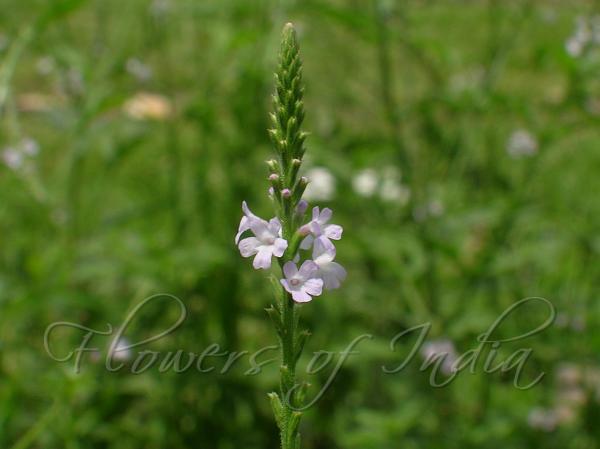|
| Vervain |
|

|

| File size | 1021289 |
| Original date | 5/21/07 12:35 PM |
| Resolution | 2048 x 1536 |
| Flash | Flash did not fire, auto |
| Focal length | 16.2mm |
| Exposure time | 1/206s |
| Aperture | 8.2 |
| Focus Distance | |
| Metering Mode | Partial |
| Camera make | NIKON |
| Camera model | E3700 |
| Sensor type |
|
|
|
Photo: |
Botanical name: Verbena officinalis Family: Verbenaceae (verbena family)
Vervain is a herbaceous perennial
with mid-green, slightly hairy, lobed, almost diamond shaped leaves. It
bears tiny,
lilac, 2 lipped flowers with a larger, 5 lobed bottom lip, borne on slender
flower spikes. The flowers open from the bottom of the spike first. It rarely
has more then 4 flowers open on the spike at any one time so it's quite
inconspicuous unless you look for it.
Once considered a very sacred herb. The druids supposedly
introduced it to the Romans. The Romans so venerated the
plant they even held an annual festival in honour of it called Verbenalia.
Roman brides also wore the flowers at weddings as it was sacred to the goddess
of love Venus. Vervain is native to Europe, Africa, Asia, Australia, including
the Himalayas, at altitudes of 100-1800 m.
Medicinal uses: Vervain makes an excellent nerve tonic and is used
in the treatment of nervous disorders, epilepsy, some respiritory problems
such as whooping cough, urinary tract problems, sedetive, detoxification, as a
digestive, a cooling wash for mild fever, sore throats some skin complaints
like eczema and for bringing out bruising. It can also be used as a refreshing
eye tonic and suprisingly it was one of the first commercial hair tonics.
Vervain makes an excellent nerve tonic and is used
in the treatment of nervous disorders, epilepsy, some respiritory problems
such as whooping cough, urinary tract problems, sedetive, detoxification, as a
digestive, a cooling wash for mild fever, sore throats some skin complaints
like eczema and for bringing out bruising. It can also be used as a refreshing
eye tonic and suprisingly it was one of the first commercial hair tonics.
Medicinal uses:
 Vervain makes an excellent nerve tonic and is used
in the treatment of nervous disorders, epilepsy, some respiritory problems
such as whooping cough, urinary tract problems, sedetive, detoxification, as a
digestive, a cooling wash for mild fever, sore throats some skin complaints
like eczema and for bringing out bruising. It can also be used as a refreshing
eye tonic and suprisingly it was one of the first commercial hair tonics.
Vervain makes an excellent nerve tonic and is used
in the treatment of nervous disorders, epilepsy, some respiritory problems
such as whooping cough, urinary tract problems, sedetive, detoxification, as a
digestive, a cooling wash for mild fever, sore throats some skin complaints
like eczema and for bringing out bruising. It can also be used as a refreshing
eye tonic and suprisingly it was one of the first commercial hair tonics.| Identification credit: R.K. Nimai Singh | Photographed in Imphal, Manipur. |
• Is this flower misidentified? If yes,